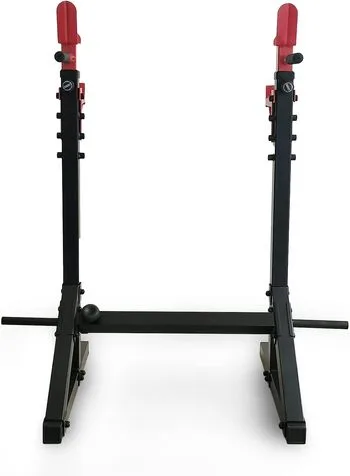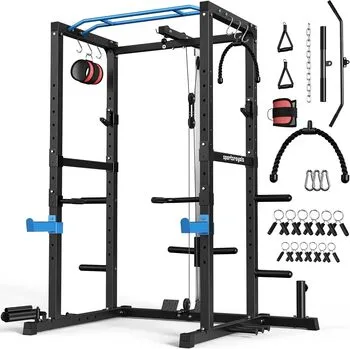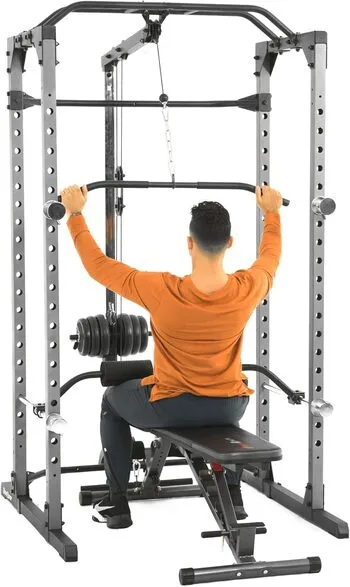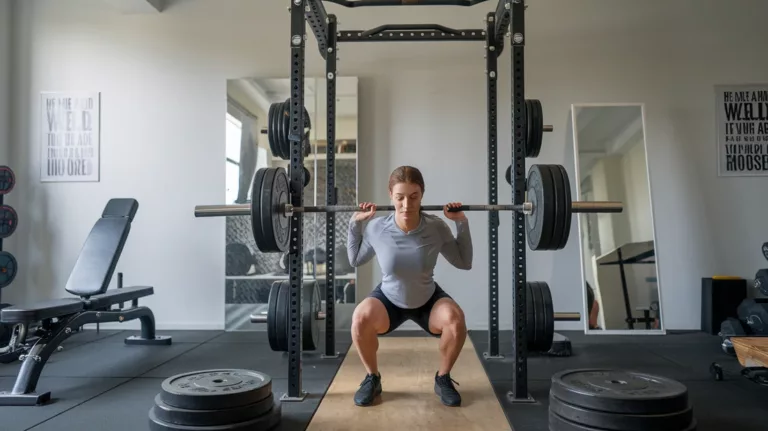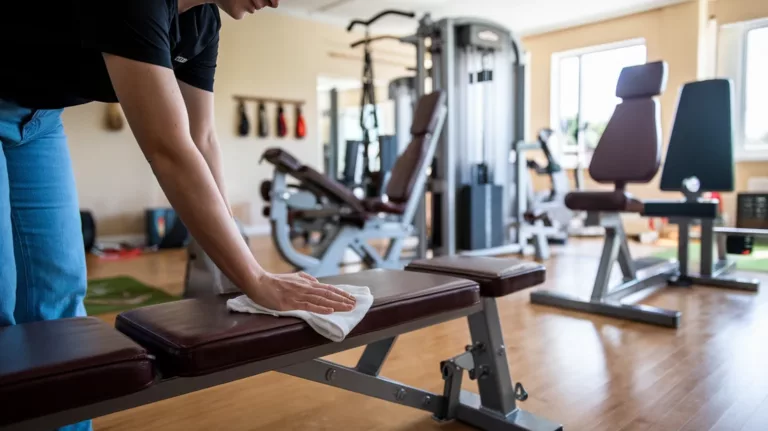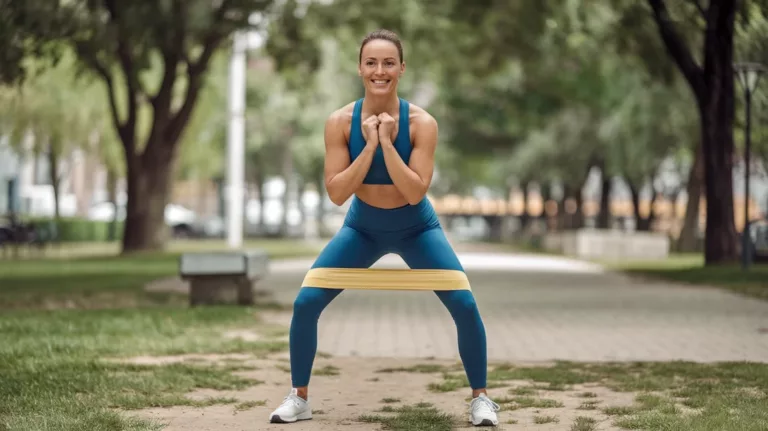Are you tired of struggling to build powerful legs at home?
Many people find it difficult to achieve their fitness goals without access to a fully-equipped gym.
However, with the right equipment, you can create an effective leg workout routine even in a limited space.
That’s where a squat rack comes in.
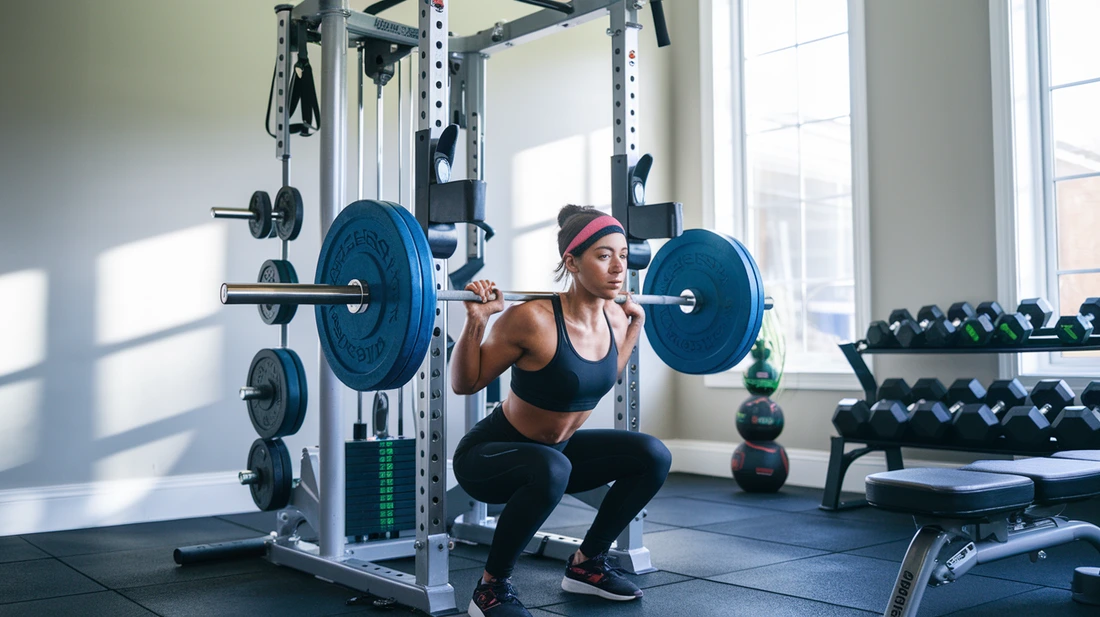
A squat rack is an essential tool for any home gym enthusiast looking to strengthen their lower body.
It provides a stable and safe platform for performing various exercises, including squats, deadlifts, bench presses, and more.
By incorporating a squat rack into your workout routine, you can target all the major muscle groups in your legs, leading to increased strength, power, and definition.
What is a Squat Rack?
A squat rack is a versatile piece of gym equipment that provides a sturdy and safe platform for performing a variety of exercises, particularly those involving heavy weights.
It’s a must-have for anyone serious about building strength and muscle, especially in the lower body.
Key features of a squat rack include:
- Adjustable height: This allows you to customize the rack to fit your height and the specific exercises you’re performing.
- Safety bars: These bars are positioned below the barbell to catch it if you fail a lift, preventing injuries.
- Weight plate storage: Many squat racks have built-in storage for your weight plates, keeping your workout area organized and clutter-free.
By using a squat rack, you can reap numerous benefits, including:
- Increased leg strength: Squats, deadlifts, and other exercises performed on a squat rack are highly effective for building strong and powerful legs.
- Improved overall fitness: A strong lower body is essential for overall athletic performance and functional fitness.
- Enhanced athletic performance: Whether you’re a runner, jumper, or team athlete, strong legs can give you a competitive edge.
- Boosted confidence: Achieving your fitness goals can boost your self-esteem and confidence.
Choosing the Right Squat Rack for Your Home Gym
When selecting a squat rack for your home gym, it’s essential to consider several factors:
Budget
- Set a realistic budget: Determine how much you’re willing to spend on a squat rack.
- Consider long-term value: A higher-quality rack may cost more upfront but can last longer and offer better features.
Space Limitations
- Measure your available space: Ensure the squat rack will fit comfortably in your home gym.
- Consider foldable or compact options: If space is limited, look for squat racks that can be folded or stored away when not in use.
Desired Exercises
- Think about your workout goals: Determine which exercises you plan to perform with the squat rack.
- Choose a rack that supports your desired movements: Some racks are better suited for specific exercises, such as powerlifting or CrossFit.
Types of Squat Racks
- Power racks: These are the most versatile option, offering multiple attachment points for various exercises like bench presses, pull-ups, and dips.
- Squat stands: Simpler and more compact than power racks, squat stands are primarily used for squats and other standing exercises.
- Half racks: These offer a combination of features from power racks and squat stands, providing a balance of versatility and space efficiency.
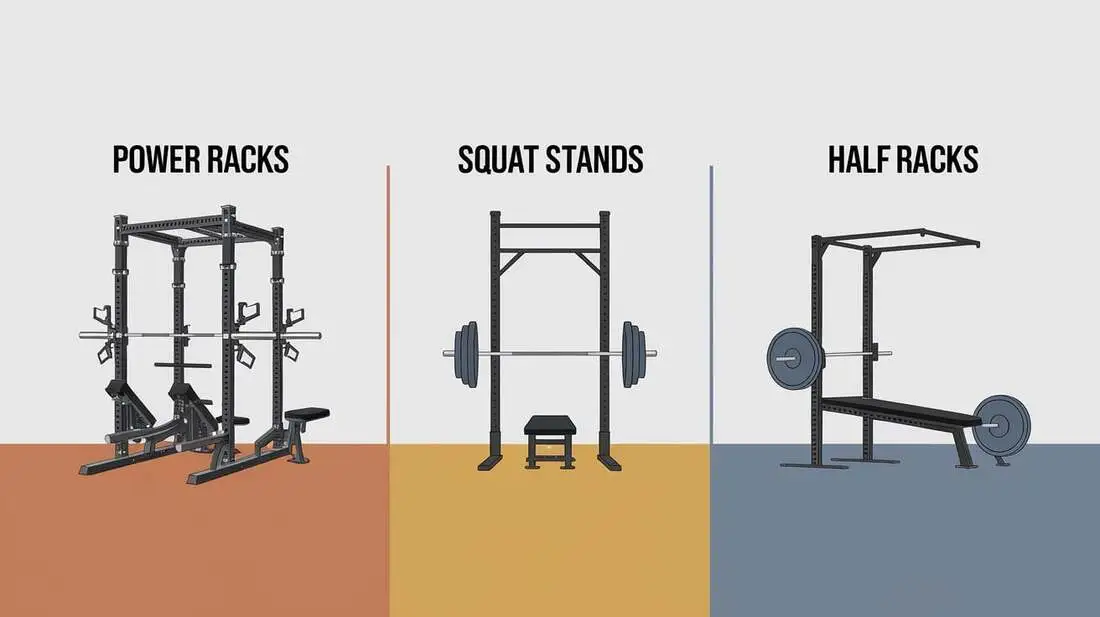
Essential Leg Exercises with a Squat Rack
A squat rack is a versatile tool that can help you build strong and powerful legs.
Here are some essential leg exercises you can perform with a squat rack:
Squats
- Back squats: A classic exercise that targets the quads, hamstrings, and glutes.
- Front squats: A variation that places more emphasis on the quads and core.
- Overhead squats: A challenging exercise that requires coordination and strength in the legs, core, and shoulders.
Deadlifts
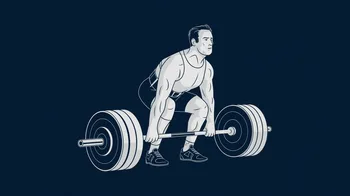
- Conventional deadlifts: A full-body exercise that works the legs, back, core, and arms.
- Sumo deadlifts: A variation that targets the glutes and inner thighs.
Overhead Presses
- Standing overhead press: A compound exercise that targets the shoulders, triceps, and core.
- Seated overhead press: A variation that can help improve stability and form.
Rows
- Bent-over rows: A great exercise for strengthening the back muscles.
- Inverted rows: A bodyweight exercise that can be performed using a squat rack’s safety bars.
Remember to use proper form and technique for each exercise to avoid injuries and maximize results.
It’s also important to gradually increase the weight and intensity of your workouts over time.
Mastering the Squat – A Comprehensive Guide
The squat is a fundamental exercise that targets multiple muscle groups and is essential for building overall strength and lower body power.
Let’s delve into the proper form, variations, and tips for mastering the squat.
Proper Form
- Stance: Position your feet slightly wider than your shoulders, toes pointed slightly outward.
- Bar placement: Rack the barbell at shoulder height, slightly below your trapezius muscles.
- Descent: Lower your body as if sitting back into a chair, keeping your knees aligned with your toes.
- Ascent: Push through your heels to drive your body back up to the starting position.
Variations
- Back squat: The most common variation, targeting the quads, hamstrings, and glutes.
- Front squat: Places more emphasis on the quads and core, requiring a different bar position.
- Overhead squat: A challenging variation that tests mobility, stability, and overall strength.
- Zercher squat: Involves holding the barbell in the crook of your elbows, emphasizing the core and quads.
Tips for Mastering the Squat
- Focus on mobility: Ensure good ankle, hip, and thoracic spine mobility to perform the squat correctly.
- Prioritize depth: Aim to go as low as possible without compromising form.
- Use a full range of motion: Avoid locking out your knees at the top of the movement.
- Engage your core: A strong core is essential for maintaining balance and stability.
- Use a spotter: If you’re lifting heavy weights, a spotter can help prevent injuries.
Remember to listen to your body and gradually increase the weight as you get stronger.
Would you like to learn about other leg exercises or discuss any specific questions you have about the squat?
Product Recommendations
The following are some top-selling squat racks on Amazon with excellent reviews:
Squat Racks
CAP Barbell Power Rack Exercise Stand
- Key Features: Adjustable height, safety bars, J-hooks, dip bars, band pegs, and weight plate storage.
- Benefits: Versatile for various exercises, durable construction, and good weight capacity.
- Price: Around $113.991
- Link: Amazon
Sportsroyals Power Cage, 1600lbs Multi-Function Power Rack
- Key Features: Adjustable cable crossover system, weight cage for home gym.
- Benefits: Multi-functional, suitable for various exercises, and high weight capacity.
- Price: Around $389.991
- Link: Amazon
Fitness Reality Squat Rack Power Cage
- Key Features: Optional LAT pulldown and leg holdown attachment, squat and bench rack combos.
- Benefits: Versatile, supports multiple exercises, and great for home gyms.
- Price: Around $249.001
- Link: Amazon
These options should give you a good variety to choose from based on your needs and budget.
Happy lifting!
These are just a few examples of popular squat racks on Amazon.
It’s always a good idea to read customer reviews and compare different models to find the best option for your needs and budget.
Tips for Effective Leg Workouts
To get the most out of your leg workouts, it’s essential to focus on the following:
Proper Form
- Prioritize technique: Always prioritize proper form over heavy weights. Incorrect form can lead to injuries and hinder progress.
- Seek guidance: If you’re unsure about proper form, consider consulting a personal trainer or watching instructional videos.
- Use a mirror: Observing yourself in the mirror can help you identify any form errors.
Progressive Overload
- Gradual increase: Gradually increase the weight, repetitions, or sets over time to challenge your muscles and continue making progress.
- Listen to your body: Avoid pushing yourself too hard, as this can lead to overtraining and injuries.
- Vary your workouts: Incorporate different exercises and rep ranges to keep your muscles engaged and prevent plateaus.
Rest and Recovery
- Adequate sleep: Aim for 7-9 hours of quality sleep each night to allow your muscles to repair and grow.
- Proper nutrition: Fuel your body with a balanced diet that includes plenty of protein, carbohydrates, and healthy fats.
- Active recovery: Engage in low-intensity activities like walking or swimming on rest days to promote blood flow and recovery.
By following these tips, you can maximize the effectiveness of your leg workouts and achieve your fitness goals.
Frequently Asked Questions (FAQs)
Can I use a squat rack for other exercises besides leg workouts?
Absolutely! While squat racks are primarily known for leg exercises, they can be used for a variety of upper body workouts as well.
Here are some examples:
- Bench presses: Use the safety bars to rack the barbell and perform bench presses.
- Overhead presses: Rack the barbell at shoulder height and press it overhead.
- Rows: Attach a barbell or dumbbells to the low rows attachment for effective back workouts.
- Pull-ups: If your squat rack has pull-up bars, you can use it for this versatile exercise.
- Dips: Some squat racks have dip bars attached, allowing you to target your triceps and chest muscles.
How much weight can a typical squat rack hold?
The weight capacity of a squat rack varies depending on the model and brand. However, most commercial-grade squat racks can handle weights up to 500-700 pounds.
For home use, a rack that can support 300-400 pounds is usually sufficient.
What is the best way to set up a squat rack in my home gym?
When setting up your squat rack, consider the following:
- Space: Ensure you have enough space around the rack for safe movement and to avoid hitting walls or other objects.
- Stability: Place the rack on a flat, stable surface to prevent it from wobbling.
- Accessibility: Position the rack in a location that is easy to access and allows you to perform exercises comfortably.
Do I need a spotter when using a squat rack?
While a spotter is not always necessary, it can be beneficial, especially when lifting heavy weights or performing challenging exercises.
A spotter can provide assistance if you need help completing a lift or prevent injuries in case of a failed attempt.
Conclusion
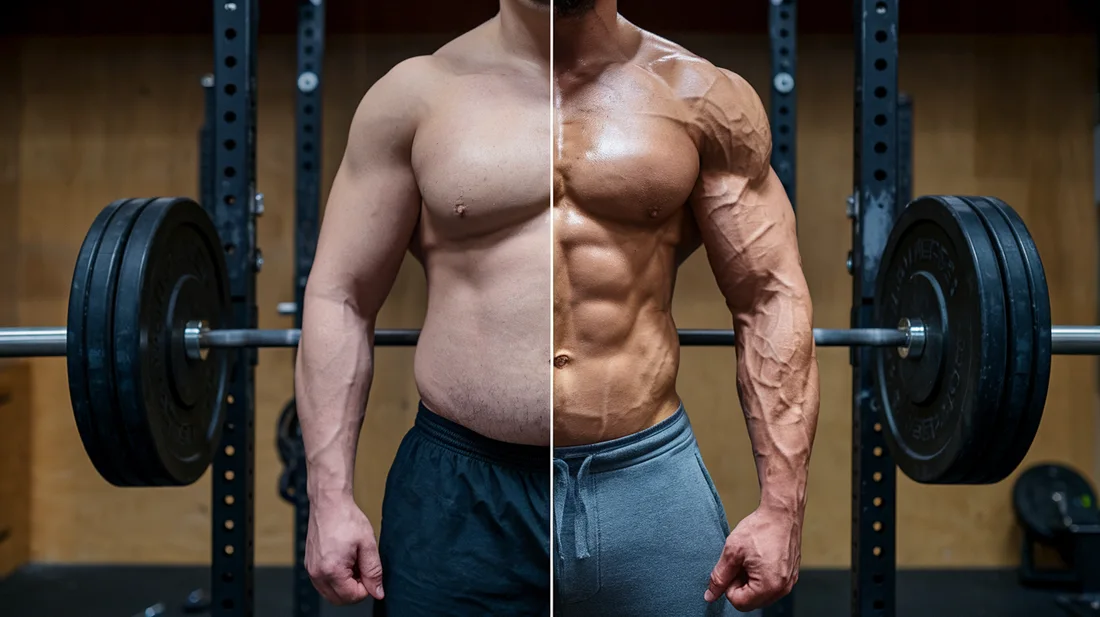
Incorporating a squat rack into your home gym is a wise investment for anyone seeking to build strong and powerful legs.
By performing a variety of exercises like squats, deadlifts, and overhead presses, you can target all the major muscle groups in your lower body.
Remember to:
- Choose a squat rack that suits your needs and budget.
- Prioritize proper form and technique to prevent injuries.
- Gradually increase weight and intensity over time.
- Rest and recover adequately to optimize muscle growth.
So, what are you waiting for? Invest in a squat rack today and start building stronger, more powerful legs.
Your body will thank you!
Key Takeaways:
- A squat rack is a valuable tool for building leg strength and overall fitness.
- There are different types of squat racks to choose from, depending on your needs and budget.
- Essential leg exercises include squats, deadlifts, overhead presses, and rows.
- Proper form, progressive overload, and rest and recovery are crucial for effective leg workouts.
Additional Resources:
- A Brief Review on the Effects of the Squat Exercise on Lower-Limb Muscle Hypertrophy. ResearchGate
- Video tutorial on how to perform squats with a squat rack
- A blog post about home gym setup tips

